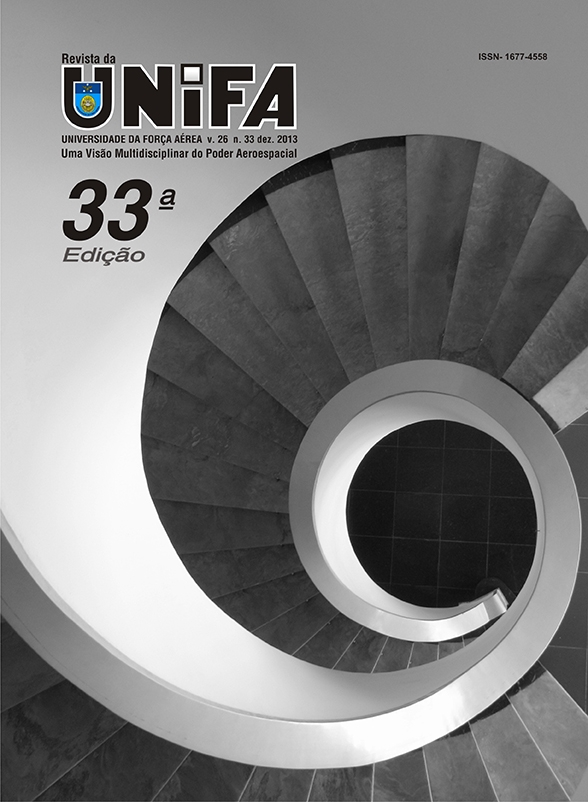Electronic Warfare Self-protection System for battlefield helicopters
DOI:
https://doi.org/10.22480/revunifa.2013.26.578Keywords:
Electronic Warfare, Self-protection, Battlefield helicopter, Life cycleAbstract
The present work proposes a methodology to support in the design phase of an Electronic Warfare Self-protection System for battlefield helicopters. Hence, the main threats and alternative systems were pointed out through literature review aiming the increase of survival probability in a hostile environment. The awareness of helicopter pilots on the degree of importance of the possible configurations of a self-protection system was also evaluated. The proposed methodology is based on the Analytic Hierarchy Process (AHP) method. A hypothetical situation employing three aerial platforms was analyzed by ten rotary wings pilots as a procedures validation. The results were consistent with possible real situations according to recent conflicts. This methodology gathers quantitative values to the results analysis instead of qualitative criteria, reducing the subjectivity in decision making process for acquisition and in the development of new projects.
References
ADAMY, D. L. EW-101: A First course in electronic warfare. Norwood: Artech House, 2001.
______. EW-102: A second course in electronic warfare. Norwood: Artech House, 2004.
AGUSTAWESTLAND. T-129: Description. Disponível em: <http://www.agustawestland.com/product/t129-0>. Acesso em: 24 set. 2012.
BLANCHARD, B. S.; FABRICKY, W. J. Systems engineering and analysis. New Jersey: Prentice Hall, 1988.
BOEING. Defense, Space and Security: AH-64 Apache. Disponível em: <http://www.boeing.com/rotorcraft/military/ah64d/index.htm>. Acesso em: 25 set. 2012.
BRASIL. Comando da Aeronáutica. Comando-Geral de Operações Aéreas. Histórico da Guerra Eletrônica:apostila do Curso Doutrinário de Guerra Eletrônica. Brasília, DF, 2012a.
______. Divisão da Guerra Eletrônica: apostila do Curso Doutrinário de Guerra Eletrônica. Brasília, DF, 2012b.
BRASIL. Comando da Aeronáutica. Estado-Maior da Aeronáutica. Ciclo de Vida de Sistemas e Materiais da Aeronáutica. DCA 400-6. Brasília, DF, 2007.
______. Política de Guerra Eletrônica da Aeronáutica; DCA 500-1. Brasília, DF, 1996.
EUROCOPTER. TIGER: Overview. Disponível em: <http://www.eurocopter.com/site /en/ref/Technology_191.html>. Acesso em: 20 set. 2012.
FIGUEIRA, J.; GRECO, S.; EHRGOTT, M. (Ed.). Multiple Criteria Decision Analysis: State of the Art Surveys. New York: Springer, 2005.
FITTS, R. E. The Strategy of Electromagnetic Conflict. Los Altos: Peninsula Publishing, 1980.
GIL, A. C. Como elaborar projetos de pesquisa. 4 ed. São Paulo: Atlas, 2007.
HEIKELL, J. Electronic warfare self-proctetion of battlefield helicopters: a holistic view. 2005. 217 f. Tese (Doutorado)-Department of Electrical and Communications Engineering, Helsinki University of Technology. Helsinki, 2005.
KREJCIE, R.V.; MORGAN, D.W. Determining sample size for research activitie. Educational and Psychological Measurement, London, n. 30, p. 607-610, 1970.
LAW, N. G. Integrated helicopter survivability. 2011. 244 f. Tese (Doutorado)-Aeromechanical Systems Group, Cranfield University. Cranfield, 2011.
LONNGREN, K. E.; SAVOV, S. V. Fundamentals of electromagnetic with MATLAB. Taiwan: Scitech Publishing, 2007.
OLIVEIRA, C. A.; BELDERRAIN, M. C. Considerações sobre a obtenção de vetores de prioridades no AHP. In: Encuentro Nacional de Docentes de Investigación Operativas. Anais... Posadas, 2008.
REINO UNIDO. Ministry of Defence. Defence Industrial Strategy: Defence White Paper. Londres, 2005.
SALGADO, M. C. V.; BELDERRAIN, M. C.; SILVA, A. C. S. Avaliação do voo tecnológico do Veículo Lançador de Satélites VLS-1 por meio de decisão em grupo. Journal of Aerospace Technology and Management, São José dos Campos, v. 1, n. 1, p. 79-90, jun. 2009.
Downloads
Published
Issue
Section
License
Copyright (c) 2013 Wellington Guilherme da Silva

This work is licensed under a Creative Commons Attribution-NonCommercial 4.0 International License.
Revista da UNIFA permite que o (s) autor (es) mantenha(m) seus direitos autorais sem restrições. Atribuição-NãoComercial 4.0 Internacional (CC BY-NC 4.0) - Revista da UNIFA é regida pela licença CC-BY-NC









